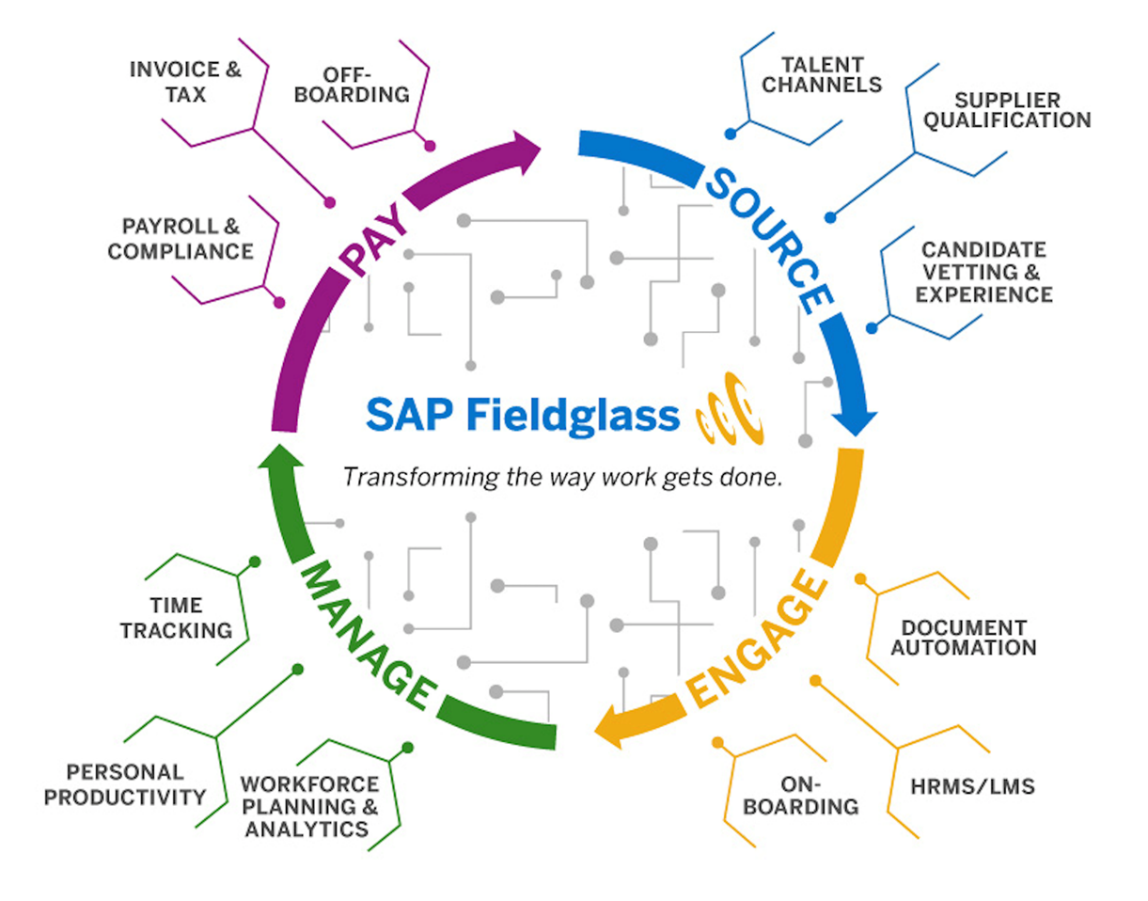Managing a diverse and flexible workforce has become a strategic imperative. Organizations are continually striving to optimize their contingent labor and services procurement processes to enhance efficiency, reduce costs, and maintain compliance. In this pursuit, SAP Fieldglass has emerged as a potent tool, offering a cloud-based Vendor Management System (VMS) to manage external workforce and services procurement seamlessly.
However, the key to reaping the full benefits of SAP Fieldglass lies in a meticulous and strategic implementation. In this article, we delve into the world of SAP Fieldglass, its significance, and the critical aspects of a proper implementation.
Understanding SAP Fieldglass
SAP Fieldglass is a cloud-based, open Vendor Management System (VMS) that allows businesses to manage external workforce and services procurement in a centralized, standardized, and automated manner. It empowers organizations to efficiently procure, manage, and optimize contingent labor and services to drive better business outcomes.
Key Features of SAP Fieldglass:
- Centralized Vendor Management: SAP Fieldglass provides a unified platform to manage all aspects of external workforce management, including vendor selection, contract management, performance tracking, and payment processing.
- Visibility and Compliance: The platform offers real-time visibility into workforce and service procurement, enabling compliance with regulatory requirements and internal policies.
- Cost Control and Optimization: Through analytics and reporting capabilities, SAP Fieldglass allows organizations to monitor costs, optimize resource allocation, and make informed decisions to enhance cost-effectiveness.
- Streamlined Procurement Process: It streamlines the procurement process by automating tasks such as requisitions, approvals, supplier onboarding, and invoicing, resulting in operational efficiencies.
- Scalability and Flexibility: SAP Fieldglass is highly scalable and adaptable to changing business needs, making it suitable for both small and large enterprises operating in various industries.
The Significance of an Effective SAP Fieldglass Implementation
A successful SAP Fieldglass implementation is crucial for realizing the platform’s potential and maximizing the return on investment. An effective implementation ensures that the system is aligned with the organization’s specific needs and goals, and that it functions seamlessly within the existing technological ecosystem. Here are several reasons why a proper implementation of SAP Fieldglass is paramount:
1. Alignment with Business Objectives:
A proper SAP Fieldglass implementation aligns the system with the overall business strategy and objectives. This alignment ensures that the platform is configured to support the organization’s unique requirements and goals, driving maximum value from the investment.
2. Efficiency and Productivity Gains:
Through thoughtful implementation, businesses can optimize their contingent workforce management processes, reducing manual effort, minimizing errors, and increasing overall efficiency. This leads to higher productivity and enhanced operational performance.
3. Cost Savings and ROI Optimization:
An effective implementation of SAP Fieldglass can help organizations identify cost-saving opportunities, streamline procurement processes, and enhance resource allocation. This, in turn, maximizes the return on investment and supports cost-effective workforce management.
4. Improved Decision-Making with Data Insights:
Properly implemented, SAP Fieldglass provides rich data and analytics that can be leveraged for insightful decision-making. These data-driven insights enable organizations to make informed choices, optimize vendor performance, and enhance strategic planning.
5. Enhanced Supplier Collaboration and Relationships:
By setting up SAP Fieldglass in a way that aligns with supplier expectations and performance metrics, businesses can foster stronger relationships with their vendors. This collaboration leads to improved service quality and more efficient supplier management.
6. Regulatory Compliance and Risk Mitigation:
A well-planned implementation ensures that SAP Fieldglass is configured to comply with regulatory requirements and internal policies. This minimizes the risk of non-compliance and associated penalties, reinforcing the organization’s legal and ethical standing.
Key Steps in Implementing SAP Fieldglass
Implementing SAP Fieldglass requires a strategic approach that involves thorough planning, collaboration, and alignment with organizational goals. Here are the key steps to ensure a successful implementation:
1. Assessment and Planning:
a. Needs Assessment: Conduct a comprehensive assessment to identify the organization’s specific needs and pain points related to contingent workforce management.
b. Define Objectives: Clearly define the objectives and expected outcomes of implementing SAP Fieldglass, aligning them with the broader business strategy.
c. Stakeholder Involvement: Involve all relevant stakeholders, including executives, IT, procurement, and end-users, to gather diverse perspectives and insights.
2. Configuration and Customization:
a. Platform Configuration: Configure SAP Fieldglass to align with the identified requirements, ensuring the system caters to the organization’s unique processes and workflows.
b. Customization: Customize the platform to meet specific needs, such as integrations with existing enterprise systems, user interface preferences, and reporting requirements.
3. Data Migration and Integration:
a. Data Mapping: Map existing data to the structure of SAP Fieldglass to facilitate smooth data migration.
b. Integration Setup: Establish integrations with relevant systems, such as ERP or HR systems, to enable seamless data flow and avoid data silos.
4. Testing and Quality Assurance:
a. User Acceptance Testing (UAT): Conduct UAT to ensure that the configured SAP Fieldglass platform meets the defined requirements and functions according to expectations.
b. Quality Assurance: Perform thorough quality checks to identify and address any defects, ensuring a reliable and robust system.
5. Training and Change Management:
a. Training Programs: Develop and execute training programs to educate users about the new system and its functionalities.
b. Change Management Strategy: Implement a well-defined change management strategy to facilitate smooth adoption and minimize resistance to the new system.
6. Go-Live and Monitoring:
a. Deployment: Roll out SAP Fieldglass in stages or as a whole, depending on the organization’s preferences and requirements.
b. Monitoring and Support: Continuously monitor the system’s performance, gather user feedback, and provide ongoing support to address any issues or concerns.
7. Optimization and Continuous Improvement:
a. Performance Review: Regularly review the system’s performance and assess its alignment with organizational objectives.
b. Feedback Incorporation: Gather feedback from users and stakeholders to identify areas for improvement and optimize the platform accordingly.
Challenges and Best Practices in SAP Fieldglass Implementation
Challenges:
- Integration Complexity: Integrating SAP Fieldglass with existing enterprise systems can be complex and challenging, requiring careful planning and execution.
- User Adoption: Getting buy-in and ensuring successful adoption by end-users can be a significant hurdle. Proper training and change management strategies are essential to mitigate this challenge.
- Data Migration: Migrating existing data to the new system without disruption to operations requires meticulous planning and execution.
Best Practices:
- Engage Stakeholders Early: Involve stakeholders from the beginning to gather requirements and expectations, ensuring their alignment with the implementation process.
- Thorough Training: Provide comprehensive training to end-users, administrators, and support staff to enable effective utilization of the system.
- Iterative Approach: Adopt an iterative implementation approach to address any issues early and incorporate feedback for continuous improvement.
- Data Quality Assurance: Prioritize data accuracy and quality during migration, performing extensive data validation to prevent errors and inconsistencies.
The Bottom Line
SAP Fieldglass offers a powerful solution for managing external workforce and services procurement, enabling organizations to optimize operations, control costs, and enhance compliance. However, reaping the full benefits of SAP Fieldglass necessitates a proper and strategic implementation.
By aligning the platform with organizational objectives, efficiently configuring and customizing it, integrating it seamlessly, and prioritizing user training and change management, organizations can unlock efficiency and visibility in their contingent workforce management. It’s essential to view SAP Fieldglass not merely as a technology implementation but as a strategic enabler for achieving business success through enhanced workforce management.
Interested in working with the Dayfoxx Resources team to select a best-fit vendor management system for your organization? Or to help your organization in planning for a Fieldglass implementation. We are here to help. Contact us today to learn how we can evaluate all VMS options with your HR and procurement teams.












0 Comments